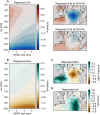Subpolar North Atlantic cooling reinforced by colder, drier atmosphere with a weakening Atlantic meridional overturning circulation
- PMID: 40465732
- PMCID: PMC12136024
- DOI: 10.1126/sciadv.ads1624
Subpolar North Atlantic cooling reinforced by colder, drier atmosphere with a weakening Atlantic meridional overturning circulation
Abstract
In contrast to global warming, the subpolar North Atlantic has experienced long-term cooling throughout the 20th century. This cooling, known as the North Atlantic cold blob, has been hypothesized to arise from reduced poleward oceanic heat transport associated with a slowdown of the Atlantic meridional overturning circulation (AMOC). Here, by diagnosing historical simulations from multiple coupled climate models, we find that ocean heat transport is not the only pathway through which the AMOC modulates sea surface temperature variability. A weakened AMOC is also associated with colder, drier lower atmospheric conditions, which lead to a reduction in surface warming expected from increasing amounts of heat-trapping gases by reducing downward clear-sky longwave radiation at the surface. This radiative pathway and the oceanic processes contribute equally to the North Atlantic cold blob. These results highlight the importance of the AMOC's impact on atmospheric properties and their radiative effects.
Figures






Similar articles
-
Global surface warming enhanced by weak Atlantic overturning circulation.Nature. 2018 Jul;559(7714):387-391. doi: 10.1038/s41586-018-0320-y. Epub 2018 Jul 18. Nature. 2018. PMID: 30022132
-
Atlantic overturning inferred from air-sea heat fluxes indicates no decline since the 1960s.Nat Commun. 2025 Jan 15;16(1):222. doi: 10.1038/s41467-024-55297-5. Nat Commun. 2025. PMID: 39814728 Free PMC article.
-
Observed fingerprint of a weakening Atlantic Ocean overturning circulation.Nature. 2018 Apr;556(7700):191-196. doi: 10.1038/s41586-018-0006-5. Epub 2018 Apr 11. Nature. 2018. PMID: 29643485
-
Overturning in the subpolar North Atlantic: a review.Philos Trans A Math Phys Eng Sci. 2023 Dec 11;381(2262):20220191. doi: 10.1098/rsta.2022.0191. Epub 2023 Oct 23. Philos Trans A Math Phys Eng Sci. 2023. PMID: 37866384 Free PMC article. Review.
-
North Atlantic Heat Transport Convergence Derived from a Regional Energy Budget Using Different Ocean Heat Content Estimates.Surv Geophys. 2024;45(6):1855-1874. doi: 10.1007/s10712-024-09865-5. Epub 2024 Oct 24. Surv Geophys. 2024. PMID: 39734426 Free PMC article. Review.
References
-
- Intergovernmental Panel on Climate Change (IPCC), “Framing and Context” in Global Warming of 1.5°C: IPCC Special Report on Impacts of Global Warming of 1.5°C above Pre-Industrial Levels in Context of Strengthening Response to Climate Change, Sustainable Development, and Efforts to Eradicate Poverty (Cambridge Univ. Press, 2022), pp. 49–92.
-
- Li L., Lozier M. S., Li F., Century-long cooling trend in subpolar North Atlantic forced by atmosphere: An alternative explanation. Clim. Dyn. 58, 2249–2267 (2022).
-
- Fan Y., Liu W., Zhang P., Chen R., Li L., North Atlantic Oscillation contributes to the subpolar North Atlantic cooling in the past century. Clim. Dyn. 61, 5199–5215 (2023).
-
- Drijfhout S., van Oldenborgh G. J., Cimatoribus A., Is a decline of AMOC causing the warming hole above the North Atlantic in observed and modeled warming patterns? J. Clim. 25, 8373–8379 (2012).
-
- Kim H., An S.-I., On the subarctic North Atlantic cooling due to global warming. Theor. Appl. Climatol. 114, 9–19 (2013).
LinkOut - more resources
Full Text Sources

